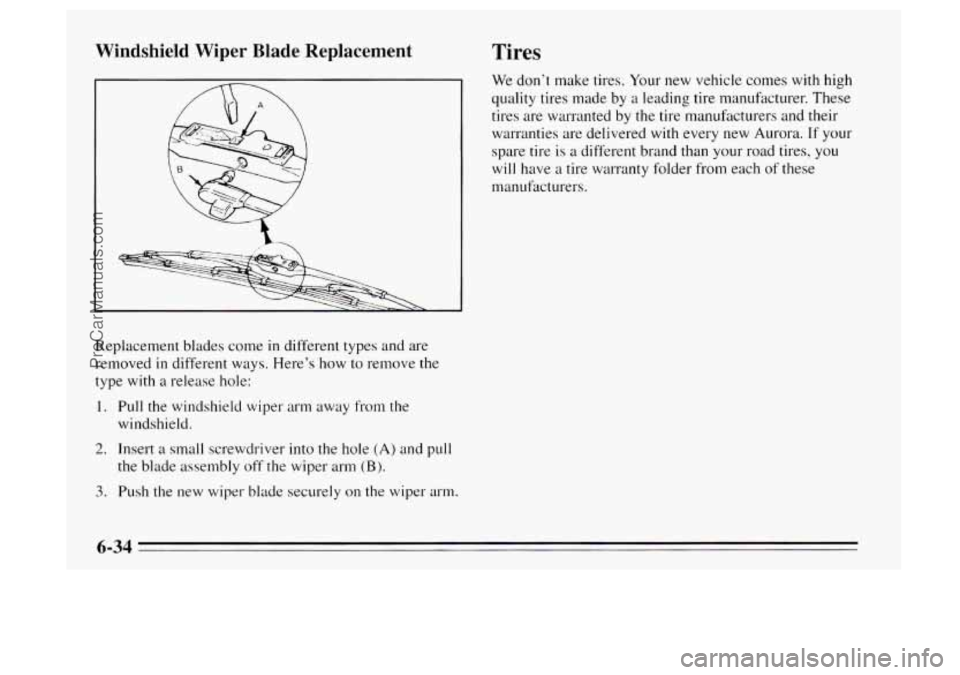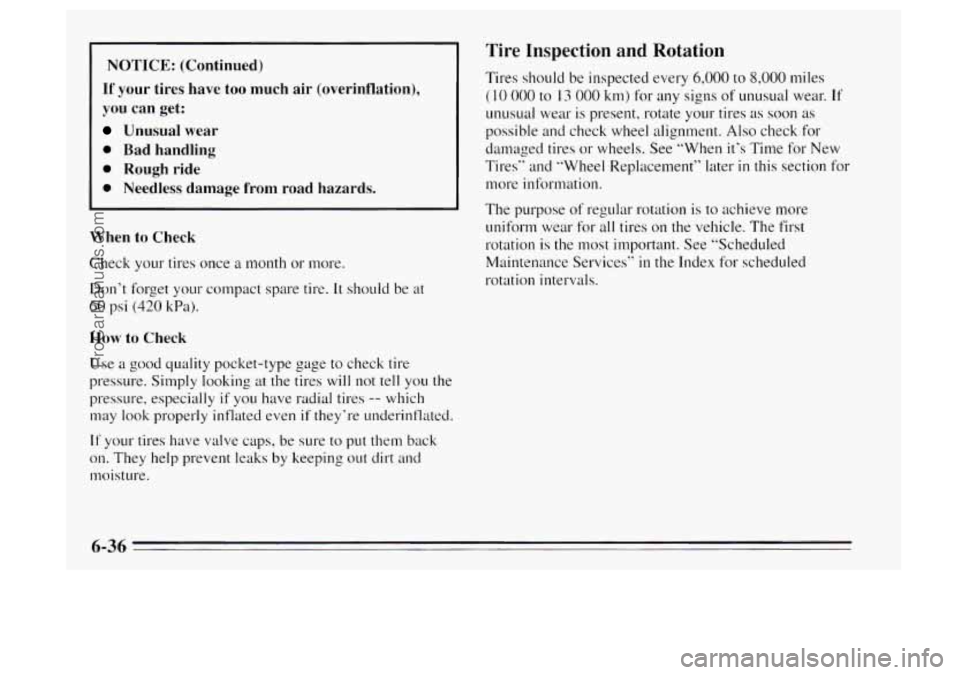OLDSMOBILE AURORA 1995 Owners Manual
Manufacturer: OLDSMOBILE, Model Year: 1995, Model line: AURORA, Model: OLDSMOBILE AURORA 1995Pages: 372, PDF Size: 19.14 MB
Page 261 of 372

3. Unclip the bulb
assembly from the
wiring harness and
replace the bulb
assembly. High Beam Bulbs
1. Pull up on the wiring harness. This unlocks the bulb.
4. Reverse steps 1-3 to replace the bulb assembly,
headlamp housing and air cleaner cover and tube.
2. Now you can reach in behind the lamp housing and
pull out the bulb.
3. To replace the bulb, angle the new bulb into the
empty socket.
4.
Push the base of the bulb down to lock it into place.
6-3 1
ProCarManuals.com
Page 262 of 372

Taillamp Bulb Replacement
For the type of bulb, see “Replacement Bulbs” in the
Index.
1. In the trunk, remove the convenience net from the
hooks. Next remove the plastic screws holding the
carpeting
in place and pull back the carpeting.
2. Unscrew the
convenience net
attachment nut. Open
the trim panel door.
3. Remove the two wing
nuts now exposed
6-32
ProCarManuals.com
Page 263 of 372

4. Remove the taillamp filler screw located to the side
of the taillamp filler panel.
5. Pull out the lamp to reach the bulb. Pull out the bulb.
To replace, push the bulb back in.
6. Reverse steps 1-5 to replace the taillamp filler, wing
nuts and carpeting.
ProCarManuals.com
Page 264 of 372

Windshield Wiper Blade Replacement
I
Replacement blades come in different types and are
removed
in different ways. Here’s how to remove the
type with
a release hole:
1. Pull the windshield wiper arm away from the
windshield.
2. Insert a small screwdriver into the hole (A) and pull
the blade assembly off the wiper arm (B).
3. Push the new wiper blade securely on the wiper arm.
Tires
We don’t make tires. Your new vehicle comes with high
quality tires made by
a leading tire manufacturer. These
tires are warranted by the tire manufacturers and their
warranties are delivered with every new Aurora.
If your
spare tire is a different brand than your road tires,
you
will have a tire warranty folder from each of these
manufacturers.
6-34
ProCarManuals.com
Page 265 of 372

Inflation - Tire Pressure
The Tire-Loading Information label which is on the rear
edge
of the driver’s door shows the correct inflation
pressures for your tires, when they’re cold. “Cold”
means your vehicle has been sitting for at least three
hours
or driven no more than a mile.
Don’t let anyone tell you that underinflation
overinflation
is all right. It’s not. If your tires
don’t have enough air (underinflation) you can
get:
Too much flexing
Too much heat
Tire overloading
Bad wear
Bad handling
Bad fuel economy.
NOTICE: (Continued)
6-35
ProCarManuals.com
Page 266 of 372

NOTICE: (Continued)
If your tires have
too much air (overinflation),
you can get:
Unusual wear
0 Bad handling
0 Rough ride
0 Needless damage from road hazards.
When to Check
Check your tires once a month or more,
Don’t forget your compact spare tire.
It should be at
60 psi (420 kPa).
Use a good quality pocket-type gage to check tire
pressure. Simply looking
at the tires will not tell you the
pressure, especially
if you have radial tires -- which
may look properly inflated even
if they’re underinflated.
If your tires have valve caps, be sure to put them back
on. They help prevent leaks
by keeping out dirt and
moisture.
Tire Inspection and Rotation
Tires should be inspected every 6,000 to 8,000 miles
( 10 000 to 13 000 km) for any signs of unusual wear. If
unusual wear is present, rotate your tires as soon as
possible and check wheel alignment.
Also check for
damaged tires or wheels. See “When it’s Time for New
Tires” and “Wheel Replacement” later
in this section for
more information.
The purpose of regular rotation is
to achieve more
uniform wear for all tires on the vehicle. The first
rotation is the most important. See “Scheduled
Maintenance Services’’
in the Index for scheduled
rotation intervals.
6-36
ProCarManuals.com
Page 267 of 372

When rotating your tires, always use the correct rotation
pattern shown here.
Don't include the conlpact spare tire
in your tire
rotation.
After the tires have been rotated, adjust the front and
rear inflation pressures
as shown on the Tire-Loading
Information label. Make certain that all wheel nuts are
properly tightened. See "Wheel
Nut Torque" in the
Index.
ProCarManuals.com
Page 268 of 372

When it’s Time for New Tires
I
You need a new tire if: One
way to tell when it’s
time for new tires is to
check the treadwear
indicators, which
will
appear when your tires have
only
1/16 inch ( I .6 trim) or
less
of tread remaining.
a
a
a
a
0
You can see the indicators at three or more places
around the tire.
You can see cord or fabric showing through the tire’s
rubber.
The tread or sidewall
is cracked, cut or snagged deep
enough to show cord or fcbric.
The tire has
a bump, bulge or split.
The tire has
a puncture, cut, or other damage that
can’t be repaired well because
of the size or location
of the damage.
Buying New Tires
To find out what kind and size of tires you need, look at
the Tire-Loading Inforrnation label.
The tires installed
on your vehicle when it was new had
a Tire Performance Criteria Specification (TPC Spec)
nu~nber on each tire’s sidewall. When you get new tires,
get ones
with that same TPC Spec number. That way,
your vehicle
will continue to have tires that are designed
to give proper endurance, handling, speed rating,
traction, ride and other things during normal service on
your vehicle.
If yo~~r tires have an all-season tread
design, the TPC number
will be followed by an “MS”
(for mud and snow).
If you ever replace your tires with those not having a
TPC Spec number, make sure they are the same size,
load range, speed rating and construction type (bias,
bias-belted or radial) as your origiml tires.
6-38
ProCarManuals.com
Page 269 of 372

Uniform Tire Quality Grading
The following information relates to the system
developed
by the United States National Highway
Traffic Safety Administration which grades tires by
treadwear, traction and temperature performance. (This
applies only to vehicles sold
in the United States.)
Treadwear
The treadwear grade is a comparative rating base(
the wear rate of
the tire when tested under control
conditions on
a specified government test course.
j on
led
For
example, a tire gkded
150 would wear one and a half
( I 1/2) times as well on the government course as a tire
graded
100. The relative performance of tires depends
upon the actual conditions of their use, however, and
may depart significantly from
the norm due to variations
in driving habits, service practices and differences in
road characteristics and climate.
Traction - A, B, C
The traction grades, from highest to lowest are: A, B,
and G. They represent the tire’s ability to stop on wet
pavement as measured under controlled conditions on
specified government test surfaces of asphalt and
concrete.
A tire marked C may have poor traction
performance.
Warning: The traction grade assigned to this tire
is based
on braking (straight-ahead) traction tests and does not
include cornering (turning) traction.
ProCarManuals.com
Page 270 of 372

Temperature - A, B, C
The temperature grades are A (the highest), B, and C,
representing the tire’s resistance to the generation of
heat and
its ability to dissipate heat when tested under
controlled conditions on
a specified indoor laboratory
test wheel. Sustained high temperature can cause the
material
of the tire to degenerate and reduce tire life, and
excessive temperature can lead to sudden tire failure.
The grade
C corresponds to a level of performance
which all passenger car tires must meet under the
Federal Motor Vehicle Safety Standard
No. 109. Grades
B and A represent higher levels of performance on the
laboratory test wheel than
the minimum required by law.
Warning: The temperature grade
for this tire is
established for a tire that is properly inflated and not
overloaded. Excessive speed, underinflation, or
excessive loading, either separately or in combination,
can cause heat buildup and possible tire failure.
These grades are molded
on the sidewalls of passenger
car tires. While the tires available
as standard
or optional
equipment on General Motors vehicles may vary with
respect to these grades,
all such tires meet General
Motors performance standards and have been approved
for use on General Motors vehicles. All passenger type
(P Metric) tires must conform to Federal safety
requirements
in addition to these grades.
Wheel Alignment and Tire Balance
The wheels on your vehicle were aligned and balanced
carefully at
the factory to give you the longest tire life
and best overall performance.
In most cases, you will not need to have your wheels
aligned again. However, if you notice unusual tire wear
or your vehicle pulling one way or the
other, the
alignment may need to be reset.
If you notice your
vehicle vibrating when driving on
a smooth road, your
wheels may need
to be rebalanced.
ProCarManuals.com